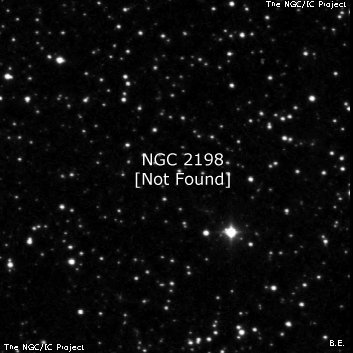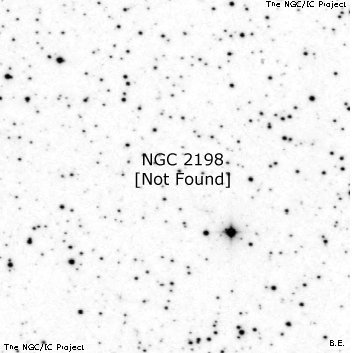NGC/IC Project Restoration Effort
(This is a very very beta version)
NGC2198


Basic Information
Location and Magnitude
Right Ascension: 6:13:54.0
Declination: +0:59:42
Constellation: ORI
Visual Magnitude:
Historic Information
Discoverer: Safford
Year of discovery: 1863
Discovery aperture: 15.0
Observational
Summary description: Cl, bet 2 st 9·10 and 10·11
Sub-type: NF
Corwin's Notes
=====
NGC 2198. Described as "A cluster, seen 1863 March 19 by J.[sic] H. Safford,
between two stars ... With the Great Refractor" at Harvard, the NGC position
actually corresponds to a field with fewer than the average numbers of stars.
As with NGC 2189 (which see) T.H. Safford measured the two stars (one is 10-11
magnitude at 06 13 32, +00 59.2; the other is 9-10 magnitude at 06 14 17,
+00 58.4, both for J2000.0), but not the cluster. The position in the NGC
was, like that for NGC 2189, concocted by Dreyer for his catalogue. It may be
that the observation, like that of NGC 2189 (which see), is given in the
Harvard Zones. If so, it could be dug out for further details, if any are
given.
Earlier, I wrote, "I see nothing in the field on the POSS1 prints that looks
like a cluster. Perhaps a visual observation can turn up something." Going
over the field again in January 2014, I see a scattered group of 20-30 stars,
probably no more than a random field, centered at 06 14 31, +01 02.2 (J2000.0)
that covers an area about 12 x 11 arcmin in size. The stars range between
9th magnitude (the eastern-most of Safford's two stars) to about 13.
Depending on the field size that his eyepiece on the Harvard 15-inch refractor
gave him, he might have picked this up. It is rather similar to two of JH's
clusters, NGC 2180 and NGC 2184 (both of which see), so could have been taken
at the eyepiece for a real cluster.
Steve's Notes
=====
NGC 2198
24" (1/22/15): at the position given here is a 10' to 12' field with perhaps a half-dozen mag 10-11 stars and a number of fainter stars. The group, though, is totally unimpressive and does not stand out in the general field. On the southwest side is a 20" pair (one of Safford's 10th magnitude reference stars). About 25' south is a scattered group of mag 9-10.5 stars (along with some fainter stars) that is much more distinctive, though doesn't match Safford's position.



